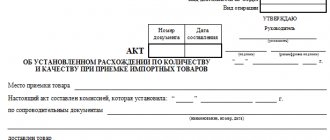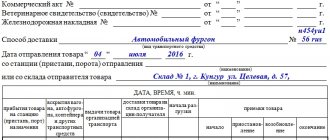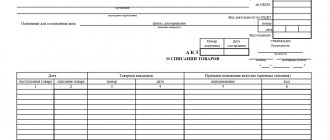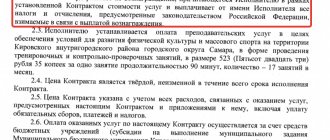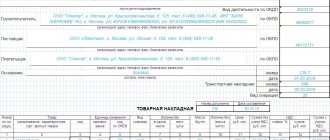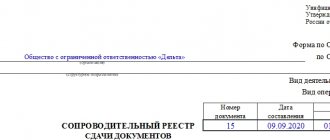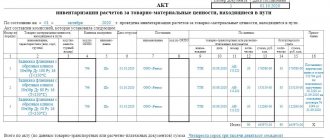Certificate of acceptance of goods: own or unified form
Until 2013, enterprises used unified forms of primary documents from the albums of the State Statistics Committee of the Russian Federation.
With the entry into force in January 2013 of the Law “On Accounting” dated December 6, 2011 No. 402-FZ (hereinafter referred to as Law No. 402-FZ), significant changes were made to the rules for drawing up primary accounting documents. Organizations received the right to independently develop certain forms of primary documents and approve them in their accounting policies. Forms from albums of unified forms are no longer mandatory for use in accounting.
This does not mean that enterprises can no longer use unified forms developed by statistical authorities. Creating an album of your own forms of primary documentation in accordance with the law is a right, but not an obligation of the organization.
Own documents must have the required details, which are specified in Art. 9 of the current Law No. 402-FZ, for example:
- title of the document and its date;
- Name of the organization;
- nomenclature of goods, works and services (fact of a business transaction) and their measurement;
- Full name, position and signatures of the persons responsible for the transaction.
Currently, it is allowed to use an act of acceptance of goods in the TORG-1 form, which was approved by Decree of the State Statistics Committee of the Russian Federation dated December 25, 1998 No. 132. You can download a sample of the TORG-1 form for an act of acceptance of goods on our website.
For an example of filling out TORG-1 when returning goods to a supplier, see the Typical situation from ConsultantPlus. Learn the material by getting trial access to the system for free.
Related documents
- Form of a book for recording the movement of work books and inserts in them
- Form of the receipt and expenditure book for recording the forms of the work book and the insert in it
- Calculation note upon termination (termination) of an employment contract with an employee (dismissal). Form N T-61
- Certificate of acceptance of completed work (Unified form N KS-2)
- Act on suspension of construction (Unified form N KS-17)
- Act on dismantling temporary (non-title) structures (Unified Form N KS-9)
- Journal of work performed (Unified form N KS-6a)
- Certificate of cost of work performed and expenses (Unified Form N KS-3)
- Act on the return of inventory items deposited (Unified Form N MX-3)
- Act on a random check of the presence of inventory items in storage areas (Unified Form N MX-14)
- Act on the control check of products, goods and materials exported from storage places (Unified Form N MX-13)
- Act on acceptance and transfer of inventory items for storage (Unified Form N MX-1)
- Record sheet for inventory balances in storage areas (Unified Form N MX-19)
- Journal of receipt of fruits and vegetables at storage sites (Unified form N MX-7)
- Journal of receipt of products, inventory items at storage locations (Unified Form N MX-5)
- Journal of consumption of fruits and vegetables in storage areas (Unified form N MX-8)
- Logbook for recording the consumption of products, inventory items in storage areas (Unified Form N MX-6)
- Journal of accounting of inventory items deposited (Unified Form N MX-2)
- Card for recording vegetables and potatoes in piles (trenches, vegetable storages) (Unified form N MX-16)
- Report on the movement of inventory items in storage areas (Unified Form N MX-20)
How to fill out the form for the acceptance of goods according to the TORG-1 form
The TORG-1 goods acceptance certificate is filled out upon receipt of material assets. When transferring the goods, their quantity, completeness, weight and quality are checked. The form is compiled by members of the selection committee authorized to do so, and by the head of the trading company.
If disagreements arise regarding quantity and quality, the parties must draw up an act in the form TORG-2 or TORG-3 (for imported goods). The act in form TORG-1 is filled out by a commission, which is appointed by order of the head of the enterprise, on the day of transfer of goods and materials. The act of acceptance of goods in the TORG-1 form can be divided into 4 main parts: the header, tabular parts on 2 pages and the final part (conclusion of the commission).
The header is designed in a standard way for many documents. It reflects:
- Name of the company and its structural division (if any).
- Document - the basis for drawing up the act, its number and date, for example an order or order.
- The place where the goods were received, such as a warehouse.
- Accompanying documents (delivery note, invoice).
- Shipper. If he is a manufacturer and supplier, then these lines are marked: “The same” or “The same.”
- Information from the insurance company.
- Number and date of conclusion of the contract, invoice for the supply of goods and materials.
- Delivery method, for example by road. When delivering by railway transport, the number and date of the railway invoice are indicated.
- When delivering food products with a veterinary certificate (for example, meat and fish products), its number and date of issue are indicated.
- Time of arrival of the goods and completion of its acceptance.
The 2nd page lists the nomenclature of supplied goods and materials, their quantity, price and cost (according to the supplier). In the tabular part of the 3rd page, the receiving party indicates the cost and actual availability of the goods by weight and number of pieces. In case of quantitative deviations from the supplier’s data, the “Deviation” column is filled in. On the 4th page, the commission records its conclusion on the compliance of the goods with the supplier’s documents and makes a manager’s decision on posting it to the warehouse.
On our website you can download a completed sample of the TORG-1 form.
What to do if you find defects in the product after signing the acceptance certificate? Study the answer to this question in Consultant Plus. If you do not have access to the K+ system, get a trial online access for free.
Leave a comment on the document
Do you think the document is incorrect? Leave a comment and we will correct the shortcomings. Without a comment, the rating will not be taken into account!
Thank you, your rating has been taken into account. The quality of documents will increase from your activity.
| Here you can leave a comment on the document “Act of acceptance of goods by quantity and quality”, as well as ask questions associated with it. If you would like to leave a comment with a rating , then you need to rate the document at the top of the page Reply for |
Recommendations for drawing up an act of acceptance of goods in the TORG-1 form
The form of documents on acceptance of goods and materials, including the acceptance certificate, must comply with legal requirements in order to avoid disputes with other organizations and tax authorities. For example, in the practice of arbitration courts, there are cases where tax inspectors refused to refund VAT from the budget to enterprises due to incorrectly drawn up acts on the acceptance of goods.
When preparing documentation for the acceptance of goods, you should follow simple rules, such as:
- Checking the presence of seals, signatures and their transcripts.
- Filling out all the necessary columns and lines in the document (number of seats, price, cost, unit of measurement, deviations, etc.).
- If the supplier of goods and materials is an individual entrepreneur who does not use printing in his activities, request a letter or indicate this fact in the contract.
- Indication in contracts for the supply of goods whether the enterprise is a VAT payer.
- Availability of accompanying documentation (veterinary certificates, invoices, waybills).
- Use handwritten signatures rather than facsimiles. In accordance with the Tax Code of the Russian Federation, documents must be signed by officials or persons authorized to do so by power of attorney. Art. 160 of the Civil Code of the Russian Federation allows the use of facsimiles to sign documents. Tax inspectors point out the fact that the Tax Code of the Russian Federation does not provide for the use of analogues of signatures. To avoid tax risks, it is recommended not to accept documents with facsimiles for accounting.
- The requirement to replace acts in the TORG-1 form in all cases of their incorrect preparation.
For more information about using facsimiles on primary documents, see the article “It is impossible to confirm expenses with a primary document using a facsimile.”
Thus, the act of acceptance of goods in the TORG-1 form is not only the basis for accepting inventory items for accounting and evidence of the supplier’s fulfillment of its obligations to the buyer, but also serves as a supporting document for the tax authorities during desk and field audits.
Features of the goods acceptance certificate in terms of quantity and quality
The specifics of the document are:
- Not mandatory. The law does not directly indicate the need to draw up such a document;
TIP: we recommend drawing up a report each time you receive goods in order to secure additional guarantees for the parties to the contract: the supplier and the buyer. When terminating a contract or if a dispute arises, it is permissible to refer to it.
- Accept the goods in accordance with Art. 509 of the Civil Code of the Russian Federation may not be the buyer personally, but the recipient;
- Availability of applications. It is worth adding documents such as a copy of the waybill, a copy of the invoice, a power of attorney, if a representative acted on behalf of the party.
PLEASE NOTE: information about the recipient must be included in the main contract.
Acts of disagreement upon acceptance of goods, forms TORG-2 and TORG-3 - sample forms
In business practice, there are circumstances in which the parties to a transaction have disagreements regarding the volume of goods or their quality indicators. For example, the accompanying documents indicate one quantity, but in fact it turned out to be completely different. In such cases, an act of disagreement is drawn up upon acceptance of the goods.
Data is entered into this document according to the real state of affairs, and it must be signed by members of the commission being created and a representative of the supplier. It must be drawn up for each supplier with whom disagreements have arisen, and for each disputed batch of goods. After registration, the act must be transferred to the accounting department with all accompanying documents.
It is noteworthy that special forms are provided for such documents, and for goods of Russian origin one form is used - TORG-2, drawn up in 4 copies, and for imported goods - TORG-3, drawn up in 5 copies.
For an act of disagreement upon acceptance of goods, a sample TORG-2 form can be downloaded on our website.
In addition to this form, the TORG-3 form is also available for download on our website.
How to correctly draw up an act for the acceptance and transfer of material assets
- Document header. This indicates when and where it was compiled. The title of the document is written, reflecting its essence. You can also note which agreement this act will become an annex to.
- Information about the parties. The full names of organizations, full names and positions of employees signing the document are written here.
- Confirmation that the supplier transfers and the recipient receives the goods, fulfilling the terms of the previously drawn up contract. The terms of payment and transfer are specified.
- Below you can list all the transferred goods in separate paragraphs. However, it is more convenient to do this using a table. It includes the name, cost, quantity. General information is indicated at the bottom of the table.
- Under the table you can indicate that the product fully meets the requirements specified in the contract, so the recipient has no complaints.
- Indicate how many copies this document has. Typically, two copies are made. They have equal strength.
- The final stage is affixing signatures. As a rule, this is done by the heads of organizations. But the company can issue a power of attorney with appropriate powers to any other employee.
It should be remembered that after the document is signed by both parties, the supplier is relieved of responsibility for the safety of the goods. After this, this responsibility is assigned to the recipient party. From this moment on, the party who received the goods cannot make any claims to the supplier. After all, she has already accepted the goods by signing the act.
Although you need to understand, situations are not excluded in which the recipient will still have claims. In this case, you will have to go to court. For example, if he proves that defects in the goods were knowingly hidden from him, or he did not have the opportunity to carefully check the condition of the goods before the transaction. In such situations, only the court will be able to determine whether there are sufficient grounds to invalidate the act.
Sample of filling out the acceptance certificate of goods in 2022
Where can I find the delivery certificate for the goods?
In some particularly difficult cases, when one invoice from the supplier (TORG-12) is not enough or the goods supplied are of particular value, an act for delivery of the goods is drawn up. In this document, the parties not only confirm the fact of delivery, but also certify with their signatures the proper quality of the goods supplied.
The significance of the act is confirmed by the fact that it is signed by top officials or executives specially authorized for this procedure.
For a certificate of delivery of goods, a sample can be downloaded on our website.
Regulatory documents governing the act
The act of acceptance of goods refers to primary accounting documents. Its writing is regulated by Article 9 of Federal Law No. 402 “On Accounting” of 2011.
Russian legislation does not provide for a strict procedure for drawing up an act. The document is drawn up in accordance with the characteristics of the product group. You can draw up one act or several. But usually they act like this - they provide a standard act, which will be changed depending on the number of products. For each specific case, a specific form is drawn up.
The act is not considered legal if it was signed by unauthorized persons. That is, counterparties who will sign the document must have an order from the head of the organization confirming this right. Also, confirmation can be a power of attorney , which is certified by a notary or a responsible person of the organization
Results
Often, enterprises ignore the need to draw up an act in the TORG-1 form and accept goods according to TORG-12, issued by the supplier. But the purpose of the TORG-12 invoice and the TORG-1 Act is different, so failure by a trade organization to draw up a Goods Acceptance Certificate can have very negative consequences for it in the future.
Read the rules for filling out the TORG-12 form in our article “Unified Torg-12 form - form and sample.”
You can find more complete information on the topic in ConsultantPlus. Free trial access to the system for 2 days.
Comment on the rating
Thank you, your rating has been taken into account. You can also leave a comment on your rating.
Is the sample document useful?
If the document “Acceptance Certificate of Goods by Quantity and Quality” was useful to you, we ask you to leave a review about it.
Remember just 2 words:
Contract-Lawyer
And add Contract-Yurist.Ru to your bookmarks (Ctrl+D).
You will still need it!
